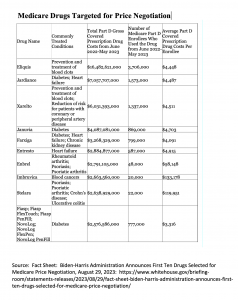The Biden administration announced the first 10 drugs covered by Medicare that will be subjected to “price negotiation” under the so-called Inflation Reduction Act (IRA).
Makers of the drugs on the list must sign an agreement to enter negotiation. If drug makers refuse, they will be subject to a tax of up to 95 percent of all their U.S. drug sales. Drug makers could also agree to not participate in Medicare or Medicaid.
Drug makers and the U.S. Chamber of Commerce have filed separate lawsuits challenging the new law, which was signed by President Joe Biden in August 2022.
Price Control or Negotiation?
For the first time, the IRA gives the federal government the authority to control the prices it pays for drugs covered by Medicare (Part D). Over the next four years, up to 60 drugs, drugs covered under Part D and Part B will be targeted for “price negotiation” and up to 20 drugs every year beyond that.
Seniors paid $3.4 billion in out-of-pocket costs for the drugs in 2022, according to the White House “fact sheet” released on August 29. Many seniors have supplemental insurance. But for those who do not, the White House says the average annual out-of-pocket cost for the drugs was up to $6,497 per enrollee.
“It is important to note that the IRA isn’t an intrusion into the free market for prescription drugs any more than the myriad laws and regulations that allow drug companies to sell at monopoly prices,” said Gregg Girvan, a scholar at the Foundation for Research on Equal Opportunity.
Bad Policy
The government created the need for price controls, says Girvan.
“Government policy has made the prescription drug market less free,” said Girvan. “Making the patent system fair, paying for drugs based on value, and removing barriers to generic and biosimilar market entry would restore a competitive drug market that is freer, and affordable for American patients.”
Drug maker Merck, whose diabetes drug Januvia is on the list, said the negotiation program is a “bad policy, that will stifle the U.S. biopharmaceutical sector’s research and development and have potentially devastating consequences for the millions of patients who need new therapeutic options.”

-Staff reports





















